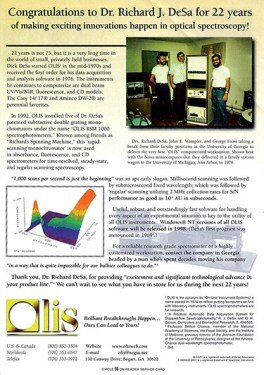Circularly Polarized Luminescence Things To Know Before You Buy
Circularly Polarized Luminescence Things To Know Before You Buy
Blog Article
Getting The Spectrophotometers To Work
Table of ContentsSpectrophotometers Things To Know Before You BuyThe Facts About Circular Dichroism RevealedMore About Circularly Polarized LuminescenceThe smart Trick of Circular Dichroism That Nobody is Talking About4 Easy Facts About Circular Dichroism Explained

Although spectrophotometry is most frequently used to ultraviolet, visible, and infrared radiation, modern-day spectrophotometers can interrogate broad swaths of the electromagnetic spectrum, including x-ray, ultraviolet, noticeable, infrared, and/or microwave wavelengths. Spectrophotometry is a tool that depends upon the quantitative analysis of molecules depending upon just how much light is absorbed by colored compounds.
Uv/vis/nir for Beginners
A spectrophotometer is typically utilized for the measurement of transmittance or reflectance of services, transparent or nontransparent solids, such as refined glass, or gases. Lots of biochemicals are colored, as in, they take in noticeable light and therefore can be determined by colorimetric treatments, even colorless biochemicals can frequently be converted to colored substances ideal for chromogenic color-forming responses to yield substances suitable for colorimetric analysis.: 65 However, they can likewise be developed to determine the diffusivity on any of the noted light varieties that normally cover around 2002500 nm using different controls and calibrations.
An example of an experiment in which spectrophotometry is used is the determination of the stability constant of a solution. A specific chemical reaction within a solution may happen in a forward and reverse direction, where reactants form products and items break down into reactants. At some time, this chemical reaction will reach a point of balance called a stability point.
The Definitive Guide to Circular Dichroism
The quantity of light that travels through the solution is a sign of the concentration of specific chemicals that do not permit light to go through. The absorption of light is because of the interaction of light with the electronic and vibrational modes of molecules. Each type of particle has a private set of energy levels associated with the makeup of its chemical bonds and nuclei and thus will soak up light of specific wavelengths, or energies, resulting in distinct spectral properties.
They are extensively utilized in numerous industries including semiconductors, laser and optical production, printing and forensic assessment, as well as in laboratories for the research study of chemical substances. Spectrophotometry is typically utilized in measurements of enzyme activities, decisions of protein concentrations, determinations of enzymatic kinetic constants, and measurements of ligand binding reactions.: 65 Ultimately, a spectrophotometer is able to figure out, depending on the control or calibration, what compounds are present in a target and exactly how much through estimations of observed wavelengths.
This would come as an option to the formerly developed spectrophotometers which were unable to absorb the ultraviolet properly.
The Buzz on Uv/vis
It would be found that this did not offer acceptable outcomes, for that reason in Model B, there was a shift from a glass to a quartz prism which permitted much better absorbance results - UV/Vis/NIR (https://soundcloud.com/julieanndesalorenz30606). From there, Design C was born with an adjustment to the wavelength resolution which ended up having three units of it produced
It was produced from 1941 to 1976 where the rate for it in 1941 was US$723 (far-UV devices were an alternative at additional cost). In the words of Nobel chemistry laureate Bruce Merrifield, it was "most likely the most important instrument ever established towards the advancement of bioscience." Once it ended up being terminated in 1976, Hewlett-Packard developed the very first commercially offered diode-array spectrophotometer in 1979 called the HP 8450A. It irradiates the sample with polychromatic light which the sample absorbs depending on its properties. Then it is sent back by grating the photodiode selection which discovers the wavelength area of the spectrum. Because then, the development and execution of spectrophotometry gadgets has actually increased exceptionally and has actually turned into one of the most ingenious instruments of our time.

The Only Guide to Uv/vis/nir
Historically, spectrophotometers use a monochromator containing a diffraction grating to produce the analytical a fantastic read spectrum. The grating can either be movable or fixed. If a single detector, such as a photomultiplier tube or photodiode is utilized, the grating can be scanned step-by-step (scanning spectrophotometer) so that the detector can determine the light intensity at each wavelength (which will correspond to each "action").
In such systems, the grating is fixed and the strength of each wavelength of light is determined by a various detector in the range. Furthermore, most modern mid-infrared spectrophotometers utilize a Fourier transform method to acquire the spectral info - https://pblc.me/pub/3fc0b3e264b77b. This strategy is called Fourier change infrared spectroscopy. When making transmission measurements, the spectrophotometer quantitatively compares the portion of light that goes through a referral solution and a test service, then electronically compares the intensities of the two signals and computes the percentage of transmission of the sample compared to the reference standard.

Report this page